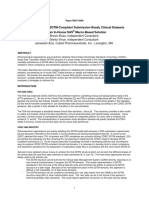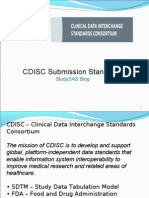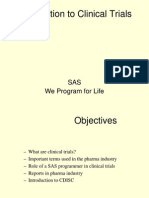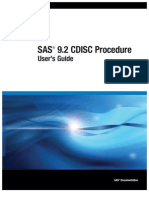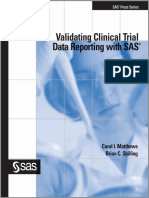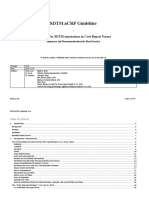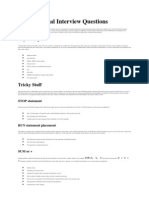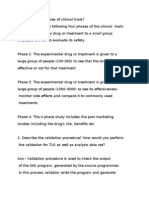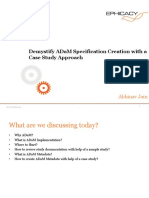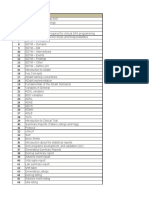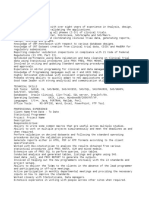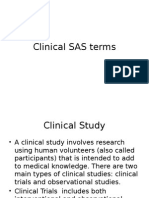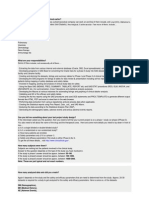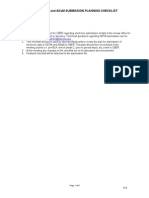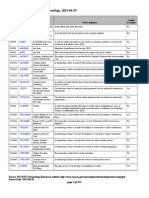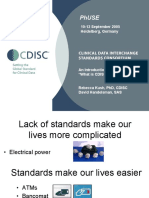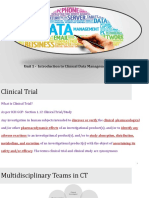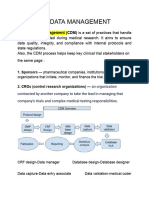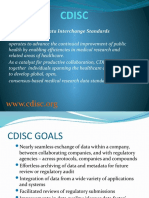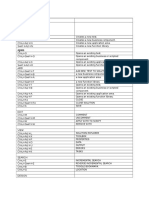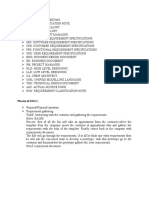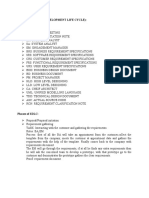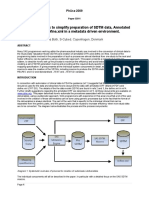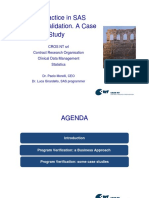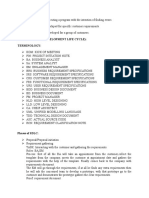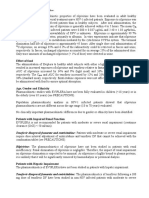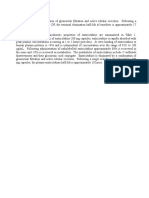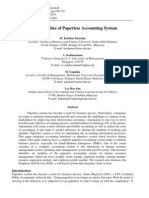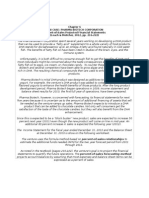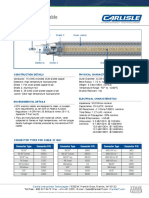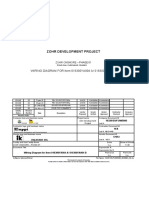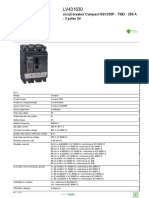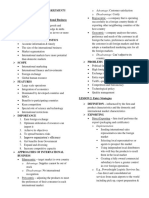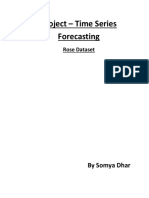Italian-Speaking
CDISC User Group 2008
Implementation of SDTM
in a pharma company with
complete outsourcing strategy
Annamaria Muraro
Helsinn Healthcare
Lugano, Switzerland
�Background
Full outsourcing service: from Study Protocol to Clinical
Study Report
Several third parties involved:
Central Lab
Central ECG
Bioanalytical data provider
CRO sub-contractors
Consultants
Studies conducted worldwide
No detailed CRF and database specification
Each CRO applies its own SOPs
Paper/Hybrid submission to FDA
2
�What drives the changes?
(2005)
Increasing number of molecules under
development
New CROs and third parties involved
Extraordinary variability in the content of CRF
forms and in the data structure
Need to create efficiencies in the data
management process and statistical analyses
Need to pool data (ISS to be performed)
To be ready for electronic submissions
3
�What needs to be standard?
STANDARD
ECG
CRF
Lab
Other
CDMS
Paper
CRF
STANDARD
STANDARD
STANDARD
SAS
Analysis
Datasets
SAS
Raw Data
Statistical
Analysis &
Data Listings
STANDARD
Study
Report
Protocol
STANDARD
Helsinn
Clinical
Storage
Area
Submission
�First steps
(Jan 2006)
Define the project scope and timelines
Present the project to Top Management
Assemble a multidisciplinary team
Project Leader
Statisticians and Data Managers
Clinicians (Phase I-III and Phase IV)
Quality Assurance
Drug Safety
Regulatory, (IT)
Core-teams
CRF standardization
Datasets standardization
Data conversion (old studies) and ISS
�Choosing CDISC
No standards available at Helsinn
Comply with FDA guidelines
Use standards already known by CROs
Simplify interchange of data with providers/partners
CDISC SDTM used as guide for CRF form (no CDASH yet)
CDISC SDTM Version 3.1.1 (+ PK domains, ver. 0.92)
CDISC ADAM Version 2.0 (and specific guidelines)
CDISC Controlled Terminology
6
�Study Data Tabulation Model (SDTM):
getting started
Improve internal CDISC know-how
Guideline review, IG version 3.1.1
Are the guidelines clear enough?
Ambiguity, individual opinions and interpretations
Official training
Understand the experience of others: European meeting
interchange
CDISC Website, public forum, webseminars
Knowledge about FDA requirements
CRO and CDISC know-how: choose the right partner for
pilot studies
7
�MAPPING
�Mapping: pilot studies
Jan 2006 / July 2006
SDTM was applied to 2 phase III and one PK
study (ongoing studies, old CRF)
First Helsinn and CRO experience
Different Guidelines interpretation
No place in the SDTM for variables collected in the CRF: a lot of
SUPPQUAL datasets
Variables collected but not needed/mapped
A lot of mapping effort
High quality, clear understanding of the
structure, purpose and attributes of each
dataset/variable
�SDTM Specifications
CRF Library
CRF design guideline
Complete set of CRF templates
Database Library
General specifications
Admitted deviations from CDISC
Analysis Datasets: general specification, list of
analysis datasets
SDTM metadata:
Dataset metadata
Variable metadata
Value-level metadata/Lab, PK dictionary
Annotated CRF
10
�SDTM specifications
CDISC general assumptions 100% implemented
Select CDISC SDTM variables
Required: all
Expected: all
Permissible (as needed)
If no place for a variable SUPPQUAL dataset
Very few derived variables included in the SDTM
Full compliant with FDA requirements (define.pdf/xml)
Excel based, very easy
11
�SDTM specifications
Datasets Metadata: dataset name, description,
structure, purpose, key variables
Variables Metadata: variable name and variables
attributes (label, length, controlled term, origin)
Value-level Metadata: define attributes and list of
terms by test code (example: list of terms for EGTESTCD,
DSDECOD)
Lab Dictionary: short and long name for each
parameter
PK Dictionary: short and long name for each
parameter
12
�13
�Variable metadata
LENGTH
(not required by FDA)
LIST OF TERMS
COMMENTS
AND NOTES
According to
the CRF
ADDITIONAL NOT
CDISC VARIABLES
14
�Terminology
CDISC Controlled Terminology: few list of terms,
applied when available
Based on terminology already used within the
Company
Code list for Lab: Laboratory Dictionary to define
lab parameter name (LBCAT, LBTEST and
LBTESTCD)
Code list for ECG: ECG code of terms (EGTEST
and EGTESTCD)
PK parameters code of terms (PPTEST and
PPTESTCD)
15
�Mapping challenges/1
Understand SDTM guidelines and establish conventions
How should the Reference start date in the DM domain be populated?
Where Code broken information may be mapped?
How diary data may be mapped?
PK datasets: how relationship between PC and PP datasets should be
set?
Trial datasets: Implementation for studies based on cycles, cross-over
studies
Inclusion/Exclusion dataset
SDTM IG: The intent of the domain model is to ONLY collect those
criteria that cause the subject to be in violation of incl/excl
We decided to include in the dataset a response to each criterion
TI (Trial inclusion) dataset prepared
Deviation dataset (DV)
A lot of discussion
Statistician need to be involved
16
�Mapping challenges/2
Variables not present in the SDTM standards
Where does ATC code go?
Extra coding information: MedDRA hierachy added in the AE dataset
Data from external provider: additional information: comment, alert flags
SUPPCM: to collect ATC codes/terms, Planned dose
SUPPEG: to collect Comment, Alert flag
SUPPLB: to collect Comments from central lab
SUPPMH: to collect Sites of Metastases
17
�Mapping challenges/3
Derived variables
--BLFL Baseline Flag: Expected SDTM variable but to be
populated according to SAP
Population Flag
Attributions used to classify study populations for analysis (ITT,
SAFETY, PP), should be placed in the SUPPDM datasets
Not included in the SDTM, present only in the analysis datasets
Variables used with a different meaning
Does the subject have significant medical history? How can we capture this
question? MHOCCUR
SDTM IG The --OCCUR variable can be used in Interventions and Events
general-observation-class domains to indicate that a solicited/prelisted
Intervention or Event did not occur, but the key here is "solicited/prelisted."
18
�Study specific issues
Cancer history mapping
MH.MHCAT
MH.MHTERM
MH.MHSTDTC
SUPPMH.QVAL
where QNAM=EXTENT
SUPPMH.QVAL
where QNAM=SITE1
19
�IMPLEMENTATION
20
�SDTM implementation
CRO may decide where to implement SDTM
CDMS (Oracle Clinical, Clintrial, EDC solutions, etc.)
SAS environment
Hybrid solutions
Linear method to be applied for generation of
SDTM and analysis datasets: process
traceability
21
�CRF, SDTM
and Annotated CRF
22
�Mapping CRFs to CDISC SDTM
April 2006-August 2006
Design the CRF having in mind the final SDTM structure
Limit collection to required and necessary data (avoid not
mapped fields)
Groups related fields in the CRF consistent with the SDTM
domain
Use fields name, list of codes in the CRF consistently with
variable labels, CT as much as possible
Allow efficient database setup
Easy mapping with SDTM database (traceability)
Reduce effort to create SDTM complaint datasets
Focus on both on content and layout
CRF Library provided to CRO with SDTM mapping
23
�Annotated CRF
Due to the variety in CRF Annotation, specifications
about Annotated CRF included in the Helsinn Standard
Library
24
�Demography
Assigned value
DS.DSTERM="INFORMED CONSENT OBTAINED" (DS.DSCAT=PROTOCOL MILESTONE)
INFORMED CONSENT
DS.DSSTDTC
Informed Consent Signature Date
dd
mmm
yyyy
Dataset
Variable name
DEMOGRAPHY
Gender
Male
Female
DM.SEX
DM.BRTHDTC
Date of Birth
dd
mmm
yyyy
DM.RACE
Race
1
2
3
4
9
White
Black
Hispanic
Asian
Other
Where condition
SC.SCORRES (SC.SCTESTCD="RACEOTH")
Specify
________________________________
25
�Medical History
MEDICAL HISTORY
MH.MHCAT="MEDICAL HISTORY"
Does the subject have any significant medical history?
Yes
No
If Yes, complete this section
MH.MHOCCUR
Disease
(prior and/or concomitant)
1.
MH.MHTERM
Ongoing
Date of Diagnosis
MH.MHSTDTC
mmm
yyyy
mmm
yyyy
mmm
yyyy
mmm
yyyy
mmm
yyyy
mmm
yyyy
mmm
yyyy
mmm
yyyy
mmm
yyyy
mmm
yyyy
Yes
No
(1)
(2)
MH.MHENRF
2.
3.
4.
5.
6.
7.
8.
9.
10.
26
�Adverse Event
ADVERSE EVENT
AE.AEOCCUR
Has the subject experienced any adverse events?
If Yes complete this section
Yes
No
Adverse Event from XXX up to YYY days from the last study drug administration < as defined in the protocol >
Adverse events ongoing at the end of the study must be followed until XXX < as defined in the protocol >
Serious adverse event must be followed until the outcome is resolved or a stable condition is reached
Adverse Event
Start and Stop Date
Occurrence
Serious
1 single episode
2 intermittent
1 Yes (*)
2 No
Intensity
Relation to
study drug
1 Mild
2 Moderate
3 Severe
1 Not related
2 Unlikely
3 Possible
4 Probable
5 Definite
6 Unassessable
AE.AESER
AE.AEREL
Action taken
Outcome
(tick all that applies)
1 None
2 Study drug interrupted
and restarted
3 Dose reduced
4 Study drug
discontinued
5 Specific
Therapy/Medication
6 (Prolonged)
Hospitalization
1 Recovered
2 Recovering
3 Recovered with
sequelae
4 Not recovered
5 Death
9 Unknown
1.
Start
AE.AESTDTC
dd
AE.AETERM
Stop
mmm
yyyy
AE.AEENDTC
dd
mmm
yyyy
dd
mmm
yyyy
AE.AEPATT
AE.AESEV
AE.AEOUT
2.
Start
Stop
dd
mmm
yyyy
dd
mmm
yyyy
dd
mmm
yyyy
3.
Start
Stop
1, 2, 3, 4 4 AE.AEACN
2
5 5 AE.AECONTR
3
6 6 AE.AEHOSP
1
If the Event is serious, fill in a Serious Adverse Event Report
27
�QC Process
Evaluate if the structure is CDISC complaint and Helsinn
SDTM requirements are fullfilled
SAS programming: PROC IMPORT of Excel datasets
specifications, PROC CONTENTS of SDTM, compare, report of
inconsistencies (variable name, label, length)
PROC CDISC: SDTM version 3.1 (but we are using 3.1.1!)
Manual review of documentation/algorithm, FDA
requirements, Annotated CRF
28
�Benefit
Facilitate electronic submissions preparation:
No need to reformatting data
ISS easily performed (but integration of old studies very
demanding)
Define.pdf document created quickly and easily
No question from FDA about data
Efficient CRF design
Process of dealing with CROs simplified by supplying
clear data specification
Clear documentation of the data process: from CRF to
analysis
High level of quality
Efficient data review
Increase SAS programming re-use within the company
29
�Lessons learned
Feasibility: standardization is easier for a small company
Timelines: needed additional time for setting SDTM for
the first studies but efficiency in the subsequent
implementation
Standardization is an ongoing process
Solid internal know-how is key of success: keep up to
date about CDISC enhancement
Flexibility may be applied for Phase I studies
New processes implemented and new SOPs are needed
Improve efficiency throughout standardization is a
company process: work with Clinicians and Regulatory
Department
30
�Lessons learned:
interacting with CROs
Provide detailed CDISC mapping specifications
CDISC CRO know-how: select provider able to deliver data on
SDTM compliant sturcture
Low level may have a large impact in the activity
Investigate CDISC know-how from first CRO contact
High level: good and proactive collaboration and efficient process
Clear definitions of expectations and sponsor/CRO involvment
Frequent interaction with CRO during mapping/implementation:
Clarifications needed, exceptions to be discussed
Interim data transfer to verify data structure
Establish a rigorous QC process
Leave CROs free to decide where to implement the CDISC models
31
�Next Steps
Focus on ADaM implementation
Be ready for eCTD
Expertise in XML
Preparation of Define.xlm
Tools to QC the submission package
Standards for non-clinical data
FDA requirements for submission of non-clinical data
CDISC SEND: evaluate feasibility
Create new standard CRF forms / datasets
Evaluate impact of new SDTM version, CDASH project and Controlled
Terminology
What else may be standardized?
Third parties (Central Lab, ECG providers) data transfer
SAS programs/macros to check the data quality before db lock
Definition of Standard Logical Checks (Data Validation Plan)
Standardize TLF formats
32
�Thank you!
Annamaria Muraro
Helsinn Healthcare,
Lugano Switzerland
amu@helsinn.com
33





